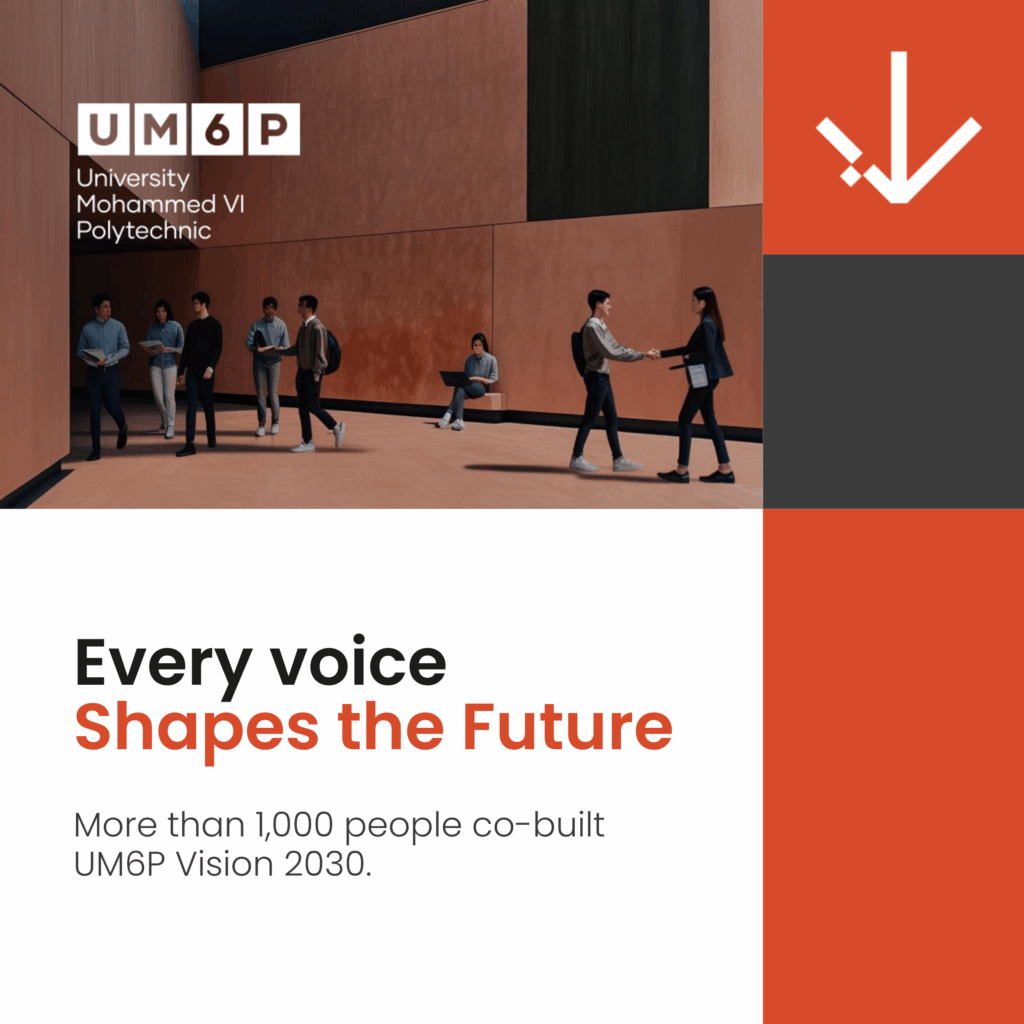How a university built for transformation is designing its future through structure, trust, and collective intelligence.
A University That Builds With Its Community

At a time when many institutions are responding to disruption, UM6P has chosen to build methodically, collectively, and from within.
Vision 2030 is a system designed to listen, organize, test, and evolve year after year with contributions from the entire university community. It emerged from a conviction that strategy is only real when it is shared and that the future of education in Africa cannot be imported; it must be designed locally, tested structurally, and scaled collectively.
In 2024, UM6P completed its second learning loop within this system. The results are not only promising, they are foundational.
With over 1,000 contributors from 77 departments and 600 ideas collected, Vision 2030 has become the university’s internal engine for transformation.
We are not working from assumptions. We are working from what people experience, suggest, and build across every part of the university.
How Vision 2030 Works: From Feedback to Implementation
The architecture of Vision 2030 is based on a simple but powerful principle: strategy must be alive. That means it is not fixed, but iterative; not abstract, but structured.
The model works through a yearly loop, composed of four phases:
- Listening & Collection: Community-wide engagement across all units
- Co-Design & Prioritization: Structured workshops, voting, and synthesis
- Testing & Experimentation: Launch of pilot initiatives across campuses
- Review & Improvement: Evaluation, reflection, and adjustments
This cycle ensures that Vision 2030 is grounded in reality and able to evolve in response to emerging needs.
Building Participation into Practice
Vision 2030 is not simply a collection of intentions; it is a system that produces measurable action. In its second cycle, the initiative reached new milestones that reflect both scale and depth.
More than 1,000 contributors participated, spanning roles from students and researchers to administrative and academic staff. Their contributions led to the formulation of over 600 ideas, addressing everything from curriculum modernization to organizational culture, from cross-campus communication to research valorization.
Feedback was not just solicited; it was structured. 7,000 feedback points were gathered, analyzed, and transformed into a navigable system of priorities. These data points became the foundation for 15 pilot projects, launched across 34 departments, with 214 direct participants engaged in implementation.
To support this dynamic, 75 facilitators were trained across the university to lead workshops and track experimentation. These facilitators are now part of a growing internal network that ensures continuity and collective accountability.
Each one of these figures tells the same story: Vision 2030 is not about consultation. It is about integration. It transforms dialogue into structure and structure into practice.
Entrepreneurship: Metrics That Reflect a System, Not a Trend
Among all three pillars, entrepreneurship received the highest priority score: 3.96/5. This came with clear expectations: accessible support structures, connections between research and market needs, and a pathway for scaling ventures.
In 2024:
- 237 startups supported
- 45% survival rate one year after launch
- Over $94.96 million raised by Moroccan startups
- 99 partnership agreements signed
- Over $250,000 in startup-generated revenue
15 strategic indicators now monitor the evolution of the ecosystem, including gender balance, social impact, and alignment with SDGs.
These achievements are not isolated success stories. They reflect the emergence of an institutional model that integrates entrepreneurship into the DNA of the university.
Education: Indicators That Reflect Expectation and Transformation
Among the top-rated indicators:
- Leadership and purpose development: 3.77/5
- Life and transversal skills: 3.79/5
- Up-to-date scientific content: 3.73/5
These indicators are now part of UM6P’s annual review mechanism and guide faculty development, curriculum planning, and student support.
Through Vision 2030, the student experience is redefined as a space for growth, autonomy, and leadership development not only academic success.
The year also saw new initiatives emerge to address student expectations more directly. These include redesigned integration journeys, leadership academies, and interdisciplinary labs embedded within academic programs.
Research: From Recognition to Application
Vision 2030 integrates new impact metrics:
- Knowledge transfer effectiveness
- IP creation for Africa
- Cross-sector initiatives
Top research priorities:
- Supervision and knowledge transfer: 3.87/5
- IP generation: 3.87/5
- Policy relevance: 3.82/5
UM6P is piloting new evaluation rubrics that include impact statements and alignment with development goals.
The aim is to strengthen research relevance while preserving scientific integrity. A balanced ecosystem where excellence and utility reinforce each other. In parallel, partnerships with African and international institutions continue to grow, reinforcing the university’s visibility and legitimacy on the continental research map.
Governance by and for the Community
Key actions in 2024:
- 1,000+ survey responses
- Meta-vision workshops in every department
- New dashboard indicators co-developed with users
This is how Vision 2030 becomes a culture.
The governance approach reflects a commitment to openness, transparency, and distributed leadership across UM6P’s entire ecosystem.
Vision 2030 is not owned by a department—it is carried by the institution as a whole. This shared responsibility is what allows the process to remain adaptive, participatory, and meaningful.
UM6P’s Vision for the Continent
UM6P is building a model for higher education leadership from Africa, for Africa.
Our vision is to lead education in Africa through strategy, structure, and collaboration.
This is the architecture that makes that vision real.

Leave a Reply